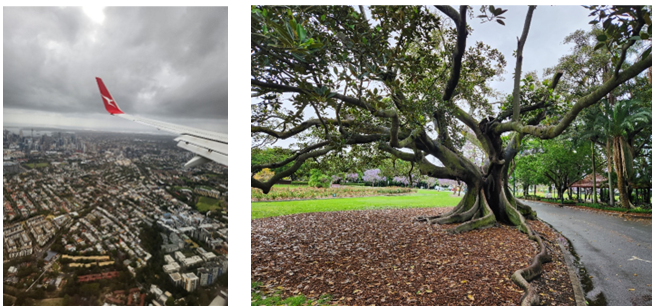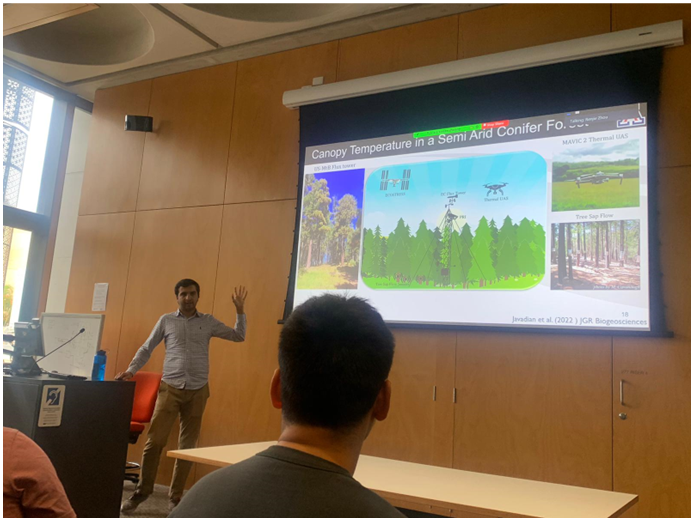Mostafa Javadian, recipient of the 2022 Secondment Program award, has completed the program and wrote the following to share with the FLUXNET community:
__________________
FLUXNET Secondment Program at the University of Queensland, Australia
By Mostafa Javadian
My FLUXNet Secondment Program was in Dr. William Woodgate’s lab at the University of Queensland in Brisbane, Australia. I have always wished to visit Australia and see the amazing wildlife that the country has to offer. In particular, I have always dreamed of seeing kangaroos in the wild. It would be an incredible experience to be able to witness these majestic creatures up close and personal. When I was applying for this FLUXNet opportunity, I could imagine myself standing in the grassy fields of Brisbane, watching as the kangaroos hop and play. I would be filled with a sense of awe and wonder at the beauty of nature. Therefore, I talked to my advisor Dr. William Smith at the University of Arizona about it, and he suggested me to contact Dr. William Woodgate at the University of Queensland. He is the PI of the Tumbarumba wet eucalypt flux tower site that has been equipped with a thermal camera with a long-term canopy temperature records which is my current focus in my research. I came up with a proposal titled “Diurnal Canopy Temperature Variation and Its Ability to Track Carbon Uptake and Water Exchange”. Thanks to FLUXNet, the proposal was funded in April 2022, the day before my Ph.D. final defense. Yes, seeing kangaroos in Australia was a dream that came true, and I had the opportunity to make this wish a reality. On October 20, 2022, I was flying to Brisbane to start my two months journey working in Dr. William Woodgate’s lab.

(Left) Picture of the plane (Qantas Airline) taken from Brisbane International Airport. (Right) View from a park in downtown Brisbane
I had a desk in Dr. William Woodgate’s office right next to him. This gave me the opportunity to work closely with him. I started to work on Tumbarumba wet eucalypt flux tower site canopy temperature data. He gave me great feedback in using Tumbarumba canopy temperature data to track carbon uptake and water exchange. Comparing results from an Arizona semi-arid grassland and Tumbarumba wet eucalypt canopy temperature showed canopy temperature was almost independent of rainfall pulses in the Tumbarumba site.
In mid-November, I was also able to go on a field trip to Northern Queensland to work on the Fletcherview tropical rangeland flux tower site with Dr. Woodgate’s lab. We used ASD FieldSpec spectroradiometers to collect spectral data around the tower from various shrubs, eucalypt trees, grasses, and soils. I also learned how to use Terrestrial laser scanning (TLS) to collect accurate structural data around the tower.

(Top left) Working with ASD FieldSpec spectroradiometers, (Bottom left and right) Collecting Structural data with Terrestrial laser scanning (TLS) in Fletcherview tropical rangeland flux tower site
Finally, I had a seminar titled “High resolution spatiotemporal thermal imaging reveals novel insights into plant water stress in dryland ecosystems” in the School of Earth and Environmental Sciences at the University of Queensland. I presented my findings from Southwest US canopy-temperature-focused projects to the students, researchers, and faculty members.

Seminar in the School of Earth and Environmental Sciences at the University of Queensland
I had two amazing months in Australia that were beyond beneficial for both my scientific career and life experience. I would like to thank the Secondment committee for allowing me to partake in the first Secondment Program, Dr. Woodgate for allowing me to work in his lab and providing me guidance throughout, and his Ph.D. students, Tim and Raja for being very supportive. I will continue these relationships and harness the many things I have learned over my time there and continue to develop my skills as a scientist.
